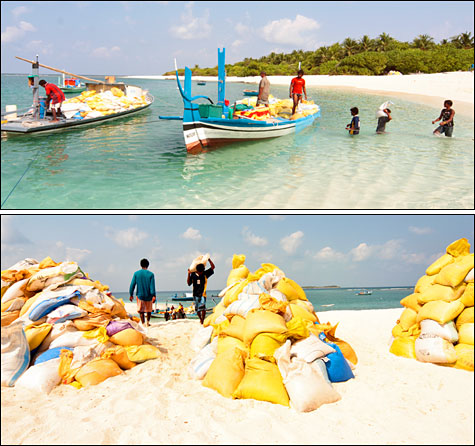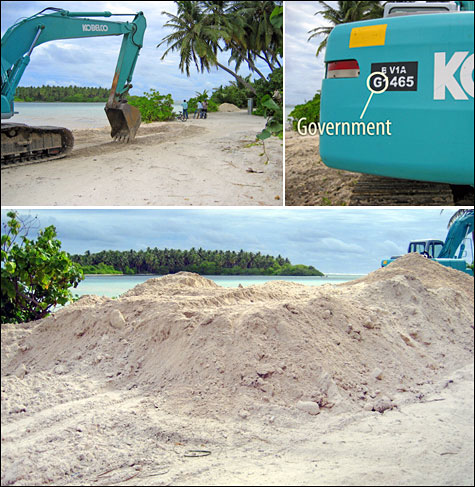SAND MINING MIGHT ERASE SOME ISLANDS FROM MAP OF MALDIVES
Since time immemorial artisanal coral sand extraction or mining from local beaches and lagoons, mainly for construction purposes, has been a common practice in the Maldives. However, within the last four decades the Maldives has been experiencing a massive boom in the construction of cement houses and high-rise concrete buildings. Up to late 1980s, almost all the cement houses and buildings were built with coral sand and coral aggregates from local beaches and lagoons. In the late 1980s, imports of river sand and aggregates from India started to replace coral sand and coral aggregates in the construction of high-rise buildings.

“UNEP’s field mission found that artisanal extraction of coral sand from lagoons (manually using sacks was evident at nearly all the islands visited. UNEP witnessed uncontrolled coral sand exploitation, and visual evidence indicates that coral sand extraction has increased since the tsunami.” (Maldives Post-Tsunami Environment Assessment Report)
India has over the years allowed the exports of these commodities to the Maldives under a special arrangement which has placed an exception on those commodities which are otherwise prohibited to be exported from India. Last year 300,000 MTs of river sand and 270,000 MTs of aggregates were allowed to be imported to Maldives from India. However, post tsunami reconstruction boom associated with developing more resorts have created a shortage of river sand. Thus the price of river sand rose from around RF490 (US$38) per ton to RF900 (US$70). Furthermore, the recent hike in prices of oil in the international market has increased the transportation costs of these commodities as well.
In 2008, India has increased the limit on export of construction materials – river sand by 30 per cent and stone aggregate by 95 per cent – to Maldives. However, the prices of river sand and aggregates have not come down.
Since most of the outer islands in the Maldives have no easy access to river sand and aggregates, the people have to get these commodities from Male’ region, and it’s too expensive to transport these commodities due to lack of a proper inter-island transport network. Poor islanders are left with no choice but mine coral sand from their own beaches even though it is prohibited.
In order to reduce the coral sand extraction from the local beaches and lagoons, it is imperative to make river sand and aggregates available nation-wide, of course, with subsidised prices, and also make available coral sand extracted during harbour dredging, in different sizes and qualities, that could be use for construction purposes.
What is ironic is that coral sand has been mined from some islands for the post tsunami reconstruction, further making these islands more vulnerable for erosion, sea level rise and storm surges. Even though sand extraction is prohibited from beaches of inhabited islands, it has been witnessed that the Government and internationals donors funded some projects involving extraction of coral sand.

Non-artisanal beach mining of Seenu Feydhoo’s southern side beach with the help of the Government earth moving vehicle to expand Feydhoo’s cemetry.
Photo: www.oursda.org
According to the “Maldives Post-Tsunami Environment Assessment Report” published by UNEP, ” A review of sand mining regulations from other countries that are less vulnerable to sea level rise and storm surges than the Maldives, France, UK, Japan, Netherlands and USA indicates sand mining in those countries is restricted to depths greater than 10m and at minimum distance from shore of 600 metres (See, e.g., www.seafriends.org.nz/oceano/seasand.htm). It is not known if the restrictions placed on beach sand mining in the Maldives have been assessed to determined their ability to protect islands from increased vulnerability.”
If coral sand mining along with other forms of coastal modification continues at the present rates, some of islands in the Maldives would be eroded due to these unwise activities. The coastal degradation caused by such undesirable activities have to be countered through protective measures that cost millions of dollars such as concrete coastal defence structures like the one around Male’. Uncontrolled sand mining has caused severe beach erosion in islands such as Fuvahmulah, and costly remedies in the form of coastal walls are in the pipeline.

“Although official statistics shows dramatic reductions in the total volumes of sand and coral extracted this may be due to the under-reporting of a now-illegal activity rather than a substantial reduction in demand.” (Maldives Post-Tsunami Environment Assessment Report)
It is pathetic that some of the islands might be erased from the map of Maldives because of our local actions much before forecast sea level rise due to global warming. If not for India’s river sand and aggregates, some of the islands might have already vanished through unreported illegal excessive mining of coral sand from the local beaches and lagoons. With the special arrangement, India is helping to save our islands from erosion by providing a substitute to coral sand and coral aggregates. One could argue that a part of India’s carbon emission could be traded off with this generous gesture to its low-lying neighbour, the Maldives.

Verena said,
July 17, 2008 @ 6:59 pm
Another hot-topic by Bluepeace, great!
We all know how expensive the Seawall around Male’ was, where reefs have been sacrificed for land reclamation (I have figures of US$ 14 million to protect 1,52km of shore). That’s a value of USD 9000 per linear meter (Edwards, 1989).
Now check this out:
Berg et al. (1998) give a detailed analysis of the replacement costs following years of CORAL MINING in Sri Lanka. The average cost varies between USD 246,000 and USD 863,000 per kilometer of protected coastline!!!
Bali, Indonesia: USD 1 million for 500m of coastline protection!!! (Cesar, 1996).
A hotel in West Lombok: USD 880,000 (over 7 yrs period) to restore their beach stretch of around 250m, allegedly damaged by past coral mining. (Riopelle, 1995)
The Maldives should learn out of these, and their own (!!) experience.
Especially because people live so close to the water and depend on their beaches (and reefs, by the way).
This is really alarming.
Nobody likes my idea of a * GREEN PARTY * in the Maldives? =)
Cheers!
Ibrahim said,
July 18, 2008 @ 11:10 pm
This is the reason for us to change our development attitude towards sustainable development. Precautionery principle needs to be adopted before severe damages are done. However the visionary politicans are sleeeping over with these issues. Actually our construction industry needs to make some sacrifices and in selected bigger islands we need to develop multi storey flats for local people and rent them in an affordable manner. This will prevent wastage on building and construction and minimise land wastage. The government must get a loan from a donor and develop such a housing scheme in islands for population consolidation. Sadly we are still undermining the lack of land resources and having a vision of reclamation instead of going vertical to make best use of the scarce land we have. Reclamation is not a solution interms of cost benefit ratio and for a longterm as irreversible environmental damages are possible. For instance isalnds in Addu do not need reclamation if a better housing scheme is developed. Im sure to develop such a housing scheme is cheaper than reclamation and the protection needed for these reclaimed lands. Many reclaimed lands especially in Thinadhoo of GDh and Hithadhu of Addu are not liveable due to their vulnerability to rain induced monsoonal flooding. Hence,such a plan can have the advantages of building more safe and hazard resistance shelters with much convineinet facilities, and making it more affordable to poor islanders. Additionally making the impact on environment and carbon foot print less.
Ibrahim said,
July 18, 2008 @ 11:13 pm
And we need a green party as Verena said. With all kinds of parties coming up its high time we realize environment has become the new agenda of politics. Soon politicians will have to face the dilemma of environmental issues to maintain their foot on ploitical ground.
Ahmed said,
July 19, 2008 @ 12:17 am
I think the international community will be shocker as how the father of environment(Gayoom) is conducting things around his own turf in Maldives. When he exaggerates the extinction factor on the effects of developed countries. How much damage is his development project causing the destruction of our little nation. Something maybe his reform minister kutti can think about reforming.
RAMACHANDRA BHATTA said,
July 19, 2008 @ 10:00 pm
It makes an economic sense to go for coral mining for settlements by the poor households in the absence of access to expensive imported river sands. Although such coral sand mining has enermous ecological damage value and also investement in the construction of alternative sea wall for beach conservation, it is more a social cost and the individual household pays only a small part of such social cost. It looks like a problem of tragedy of commons. We must go for some economic -institutional system to avoid such damage.
Ali said,
July 20, 2008 @ 8:39 am
resort owners do it too. specially the bigger ones. Velassaru (laguna) is an example. they dredge the shallow part of the lagoon onto the beach and use the sand for construction of the resort and have also used the sand on building their other resots.
Verena said,
July 22, 2008 @ 7:54 am
I can fully understand poor people, somewhere abandoned on an island, away from Male’ civilization to use their beach(lagoon sand for houses.
But what is going on now, dredging a channel here, and there, and for another row of water bungalows etc. – if the government doesn’t regulate this – which resort owner will care?
I’m just thinking of Reethi Rah… 8 times bigger now and lots of environmental problems (at the beginning, at least, don’t know about now). There was an EIA even for this idiotic project – and who approved that???
I don’t know who really wants that? Think the trend rather goes towards sustainable eco-tourism.
Dredge around too much and say bye-bye to your house reef…
So who’s gonna start the GREEN PARTY =) =) =)
I’m not skilled in that and unfortunately not a citizen, but I’m sure there are maaaaany people out there in your country who are able to do that.
Register!